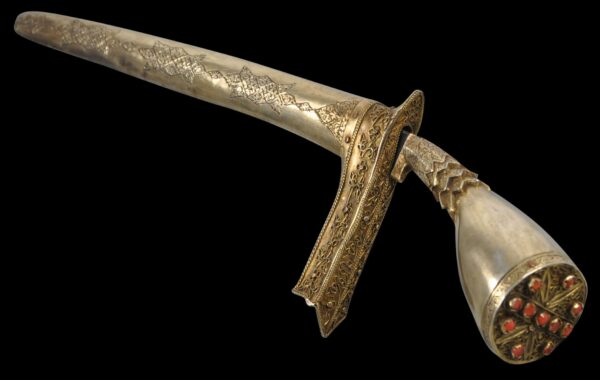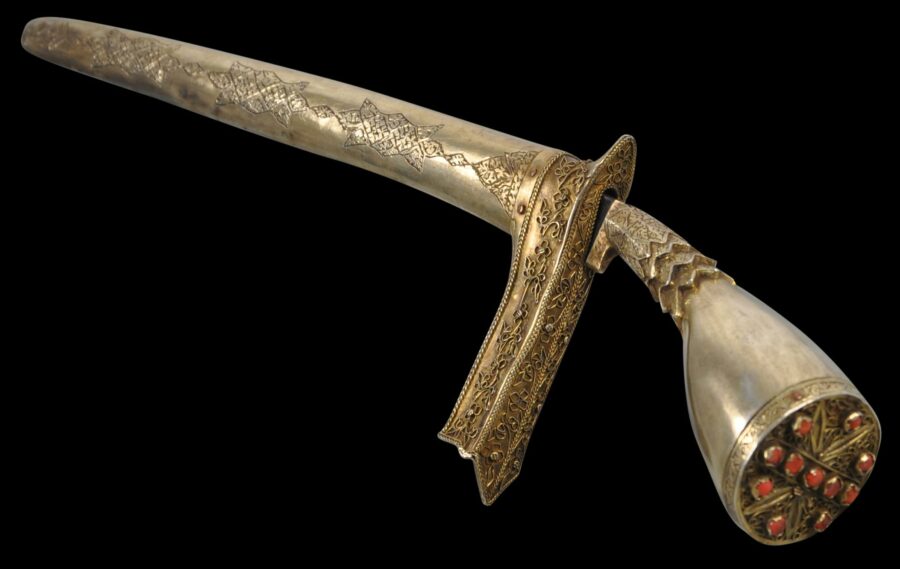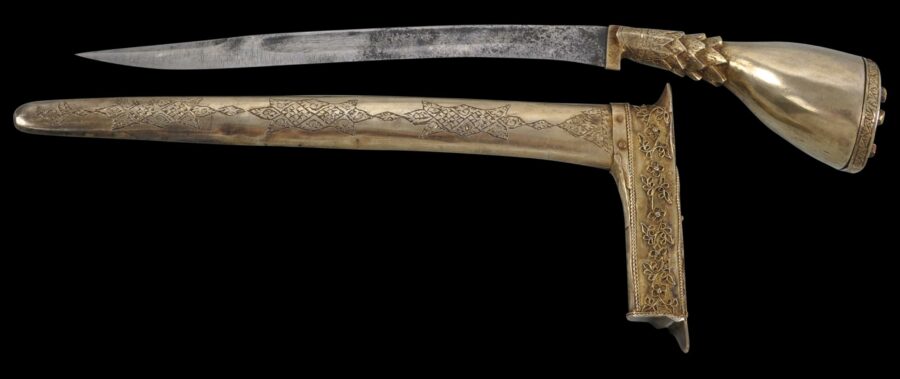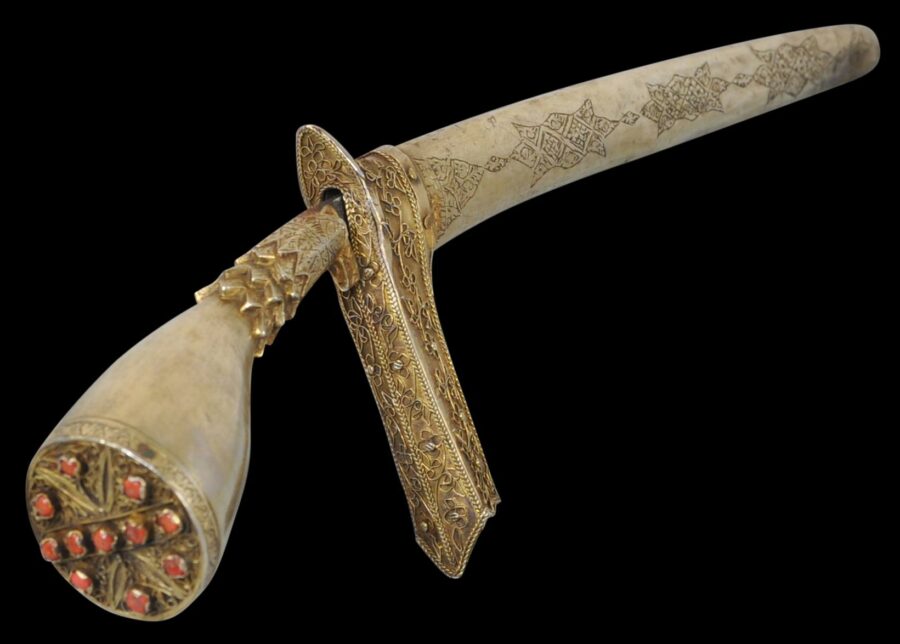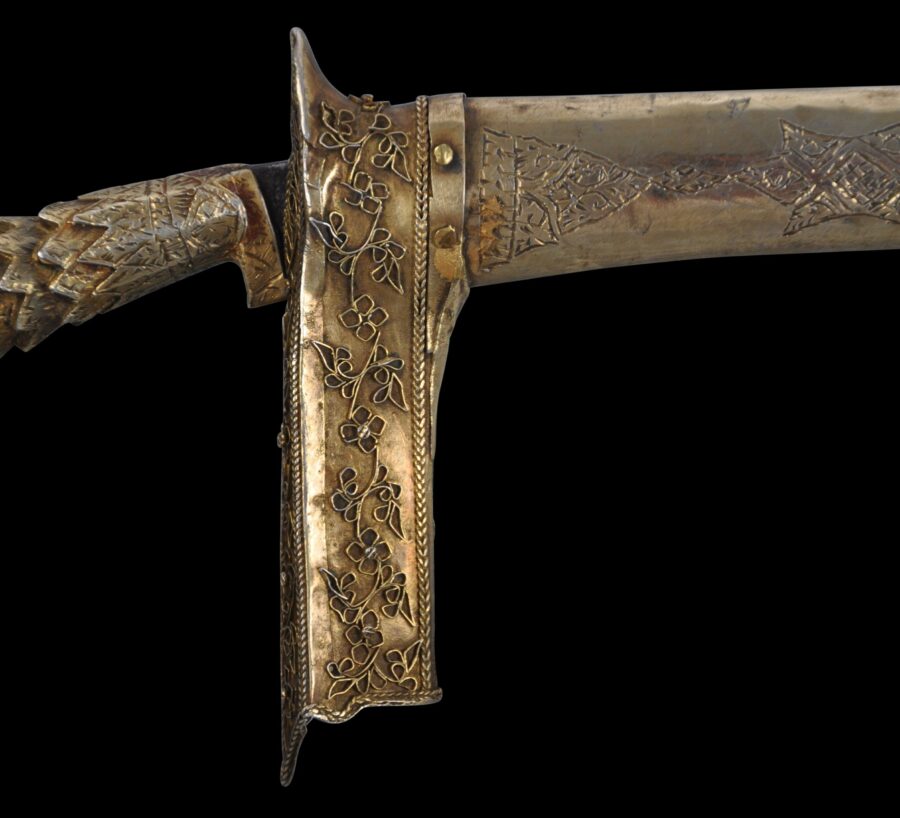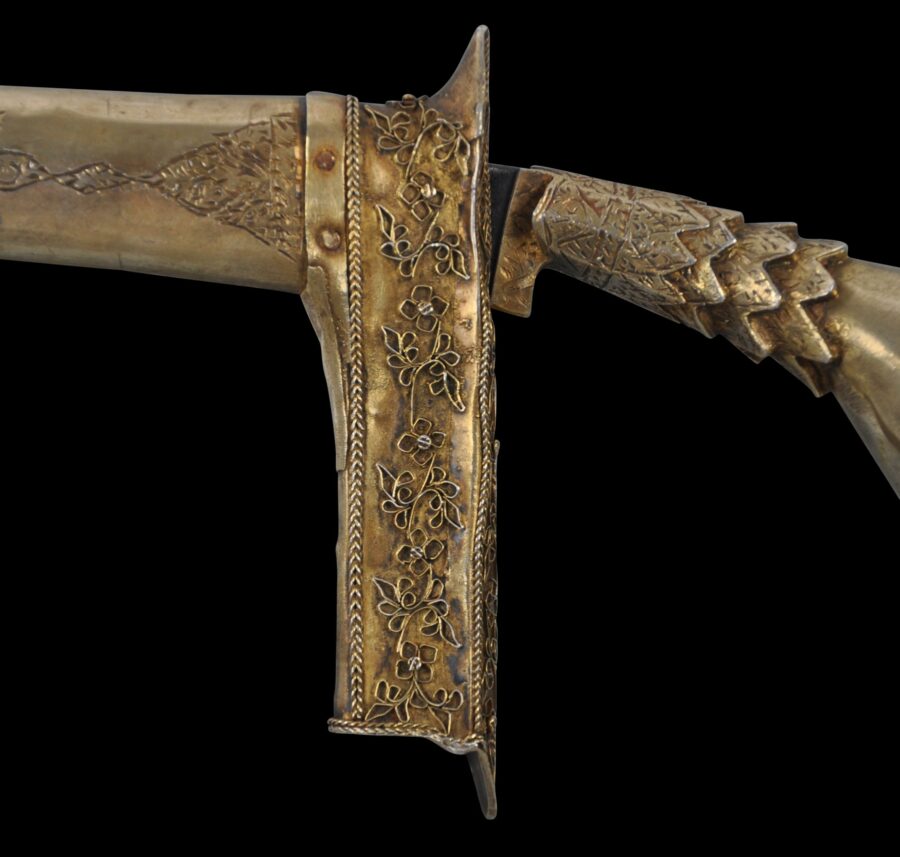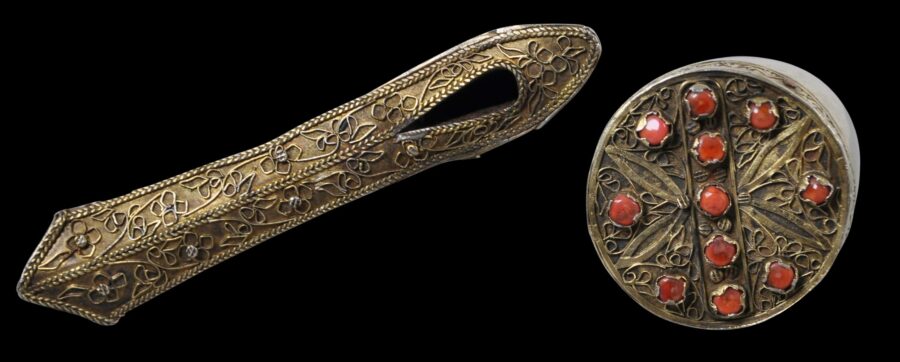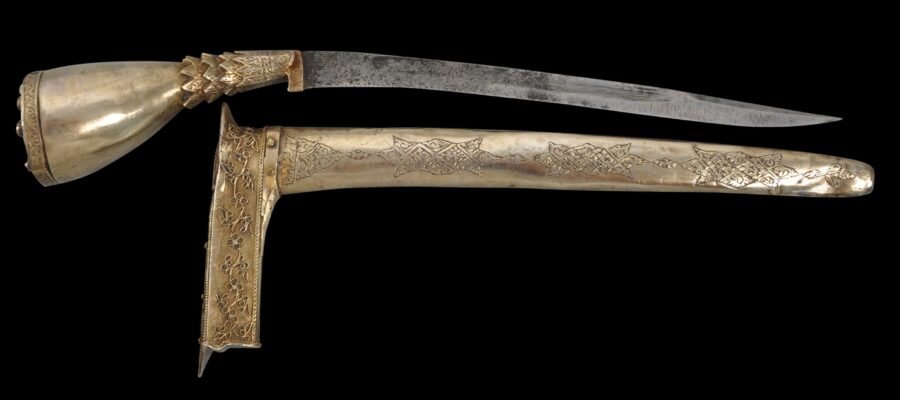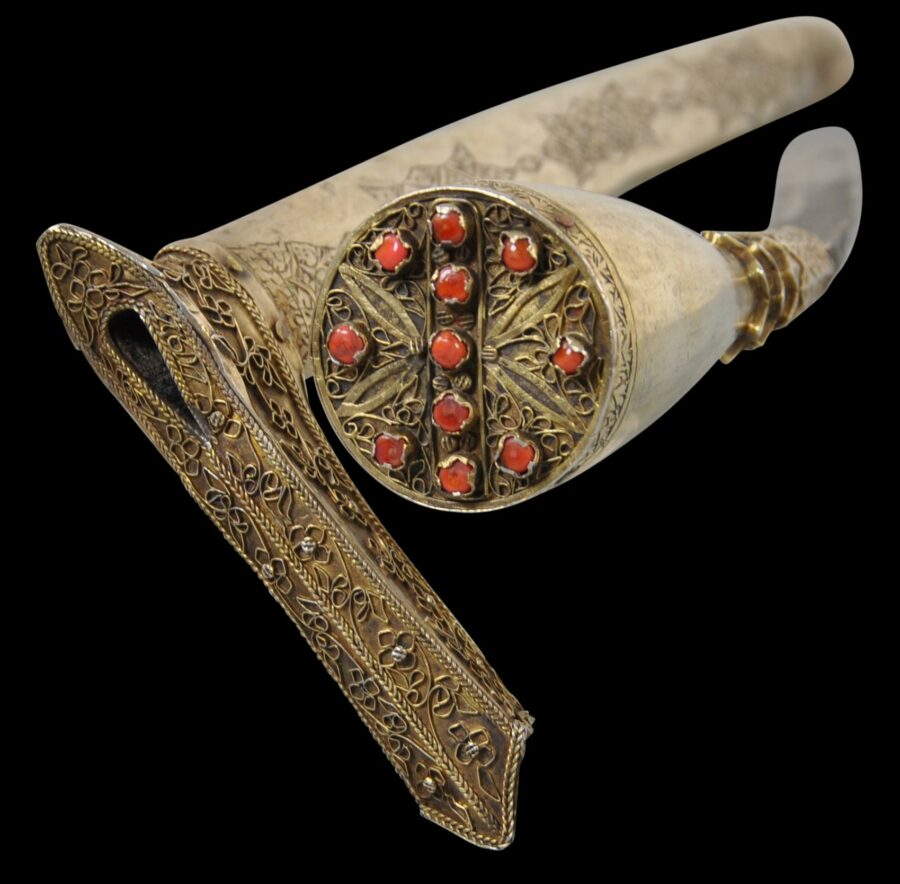This fine dagger is known as a siwaih and is from Aceh, an Islamic sultanate on the northern tip of Sumatra in what is now Indonesia, and dates to around the 19th century.
It has a curved chiselled blade and a bulbous gilded-silver hilt.
The end of the hilt is enclosed by a gilded silver plate set with red stone cabochons in a floral or star pattern and surrounded by applied gilded silver filigree. The type of filigree used – with hammered strips of flattened silver wire is very typical of Acehnese silver and goldwork.
The collar of the hilt comprises a border of three tiers of repeated V-shaped pucuk rebang (bamboo shoot) motifs in gilded silver and engraved with additional detail.
The cross-guard is of gilded silver with applied filigree in meandering flower pattern.
The scabbard is of wood encased in silver sheet that has been chased with Islamic-inspired geometric patterns.
The sewar is a dagger of Indian origin designed to be worn through the belt. In the Acehnese dialect it is known as a siwaih, and a royal siwaih with fine gold work is known as a siwaih meukeurawang (also sometimes spelt siwaih meurawang). The siwaih is similar to the more usual Acehnese dagger, the rencong, but as Leigh (1989, p. 52) says, the siwaih was a ceremonial weapon whose ownership was the prerogative of the sultan, the nobility and other men of wealth.
It is likely that the siwaih here was intended for the nobility given that it is of gold-plated silver. It is in fine condition with no obvious losses. There is some, minor old rust staining to the blade and some minor denting to the scabbard.
The Sultanate of Aceh
Aceh is located at the northern tip of Sumatra with the Indian Ocean on one side and the Malacca Strait on the other. It is a Muslim stronghold in Southeast Asia that for centuries had more contact with the Muslim centres in India, the Middle East and Ottoman Turkey than any other Islamic centre in Southeast Asia. Also, it has long had trade links with other parts of the world. It is thought that the earliest written Indian reference to Sumatra, a fourth century Indian Buddhist Sutra, refers to trade with Aceh, to the 42 kinds of perfume and the white glass produced there (Leigh, 1989). Later records refer to the Acehnese capital as having a cosmopolitan merchant class of Persian, Arab, Indian, Chinese and other Southeast Asian traders. Aceh’s economy, being coastal, saw it develop a strong trading emphasis linked to other entrepots in the region such as Penang and Malacca, as well as to cities much further afield.
Aceh long has held an evocative place in the imaginations of Europeans ever since the Sultan of Aceh sent a letter to Queen Elizabeth I of England in 1585 which marked the beginning of a trade agreement between the two countries. The Sultan famously introduced himself thus:
‘I am the mighty ruler of the regions below the wind, who holds sway over the land of Aceh and over the land of Sumatra and over all the lands tributary to Aceh, which stretch from sunrise to sunset.’
By the sixteenth century, Aceh had become the ‘Gateway to Mecca’ – pilgrims from Southeast Asia gathered there before leaving for the Holy Land. It became an important centre for Islamic religious study for Indian, Persian, Arab, Malay and Javanese scholars. Surat in India was an important station for pilgrims travelling to Mecca from the East and so strong commercial, religious and cultural links developed between Surat and Aceh. Aceh became an important Sufi centre as well, although by the twentieth century, modernist Islam had largely replaced this tendency.
Aceh’s trade, religious and cultural links brought wealth leading to a Golden Age for the Sultanate. The Sultanate was so well known by the early seventeenth century that travellers on the eastern side of the Cape of Good Hope who were heading to Sumatra merely said that they were going to Aceh (Leigh, 1989). It was now the wealthiest city in the region.
The close links between Aceh and the rest of the Islamic world saw significant Mughal, Ottoman and Persian influence on Acehnese art. The Acehnese rulers adopted Mughal architecture, garden design, and court dress. Aceh became home to traders and craftsmen from Persia, India and Istanbul and this further had a significant impact on the arts. In this way, enamelling on precious metals was introduced from Persia and Istanbul.
Sumatra was a source of gold and became known as the ‘Island of Gold.’ Gold was sieved from the rivers of eastern Sumatra and mined in the Minangkabau hills. After the expansion of the sultanate down the west coast of Sumatra, most of the Minangkabau gold was directed through Aceh and contributed to the wealth of the sultanate. And when the Minangkabau gold mines were lost, new ones were found in Acehnese territory (Reid, 1988).
The gold was put to good use, as were the diamonds that came from Borneo, carried to Aceh by Bugis traders. Sixteenth and seventeenth century Aceh was home to magnificent court rituals and ceremonies staged for important court events such as births, deaths, marriages and circumcisions, and events for visiting ambassadors. Gold, silver and gems all played a conspicuous role in the festivities. A seventeenth century visitor (quoted in Reid, 1989) described one court event thus:
‘All the singers with good voices sang while striking their dap drums which were encrusted with jewels and made of gold, suasa and silver, and their repana drums were the same. The various types of singers of zikir all wore gold studded jewels, lapis-lazuli and suasa.’
Another seventeenth century visitor marvelled at the farewell procession for the Siamese ambassador (also cited in Reid, 1989):
‘We met his majesty in most royal state on the way to the church with great solemnity. He had for his guard [that] went before him, 200 great elephants, 2,000 small shot, 2,000 pikes, 200 laces, 100 bowmen; 20 naked swords of pure gold carried before him…A horse [was] led before him, covered with beaten gold, the bridle set with stones…His majesty rode upon an elephant, his saddle of pure gold; his slave behind him in rich array, with his betel box and a fan of pure gold in his hand, to keep the flies from the king. The king’s robes were so rich that I cannot well describe them. He had a turban upon his head, set with jewels and precious stones invaluable; kris and sword of pure gold, the scabbard set with stones. Before him went an elephant with a chair of state, covered all with beaten silver…’
By this time, Aceh’s capital rivalled those of Europe in terms of wealth and population. The population was estimated to have been between 50,000 and 100,000 (Leigh, 1989). Towns along the west coast of the Malay Peninsula were required to pay tribute to the Acehnese sultan, although Malacca was under control of the Portuguese by the early sixteenth century.
The capture of Malacca by the Portuguese saw Aceh forge a formal alliance with Ottoman Turkey whereby the latter agreed in the mid-sixteenth century to supply weapons, ships and men to assist Aceh in its defence against the Portuguese. These resources were used by the Acehnese to extend their control of the pepper trade southwards. The relationship with Turkey continued until the nineteenth century and in 1873, the Acehnese requested Turkish help to repel the Dutch.
The Dutch colonial government declared war on the Aceh Sultanate on 26 March 1873 using discussions between representatives of Aceh and the US in Singapore as a pretext. An expedition under Major General Kohler was sent out later in the year. The Sultan requested and possibly received military assistance from Italy and the British in Singapore. Kohler was killed and the Dutch sent more expeditions which ultimately were successful in capturing Aceh. The last sultan finally was removed in 1903, and the splendour of the court, by now quite diminished, came to an end.
References
Asian Civilisations Museum, Sumatra: Isle of Gold, ACM, 2010.
Bennett, J., Crescent Moon: Islamic Art & Civilisation in Southeast Asia, Art Gallery of South Australia, 2005.
Brinkgreve F, & R. Sulistianingsih (eds), Sumatra: Crossroads of Cultures, KITLV Press, 2009.
Jasper, J.E. & Pirngadie, De Inlandsche Kunstnijverheid in Nederlandsch Indie V: de Bewerking van Niet-Edele Metalen, 1930 (reprinted 2009 by Sidestone Press, Leiden).
Leigh, B., Hands of Time: The Crafts of Aceh, Penerbit Djambatan, 1989.
Ibbitson Jessup, H., Court Arts of Indonesia, The Asia Society Galleries/Harry N. Abrams, 1990.
Reid, A., Southeast Asia in the Age of Commerce 1450-1680, Volume 1: The Lands below the Winds, Silkworm Books, 1988.
Reid, A., ‘Elephants and water in the feasting of seventeenth century Aceh’, in Journal of the Malaysian Branch of the Royal Asiatic Society, Part II, 1989.
Smith, H., Aceh: Art and Culture, Oxford University Press, 1997.
Stone, G.C., A Glossary of the Construction, Decoration and Use of Arms and Armor in all Countries and in all Times, first published in 1934, Jack Brussel, 1961.
Wassing-Visser, R., Royal Gifts from Indonesia: Historical Bonds with the House of Orange -Nassau (1600-1938), Waanders Publishers, 1995.
Van Zonneveld, A., Traditional Weapons of the Indonesian Archipelago, C. Zwartenkot Art Books, 2001.
Zandvliet, K. et al, The Dutch Encounter with Asia 1600-1950, Rijksmuseum Amsterdam, 2002.


